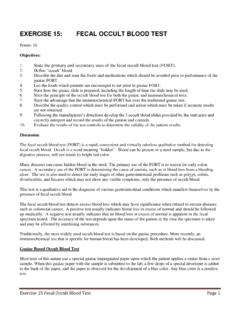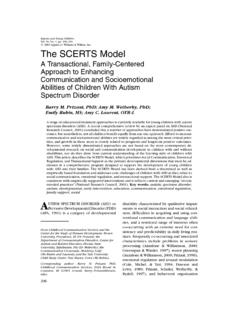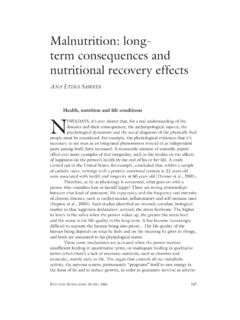Transcription of Realist Evaluation Ray Pawson and Nick Tilley 2004
1 1 Realist Evaluation Ray Pawson and nick Tilley 20041 1 The preparation of this paper was funded by the British Cabinet Office. See also Pawson , R. and Tilley , N., Realistic Evaluation , Sage, 1997 2 Realist Evaluation Ray Pawson & nick Tilley Contents: Introduction 1. The nature of programmes and how they work 2. Basic concepts in the explanation and understanding of programmes 3. Strategies and methods of Realist Evaluation 4. Realism s place in the policy cycle: formative, summative and synthetic approaches 5. The nature, presentation and use of findings from Realist Evaluation 6.
2 Conclusion: strengths, limitations and relationships with other approaches Appendix I Thinking it through : an exercise in Realist hypothesis making. Appendix II Varieties of Realist Evaluation : pocket illustrations of quantitative, qualitative, formative and synthetic applications. Appendix III Would it work here? : a grid to help decide on the feasibility of mounting a programme on your patch . References Introduction Realist Evaluation is a species of theory-driven Evaluation . Some of the differences between it and fellow members of the genus (programme theory Evaluation , theories-of-change Evaluation ) will be noted in the course of the section.
3 What should be stressed in the first instance, however, is the commonality. In all of these perspectives social programmes are regarded as products of the human imagination: they are hypothesis about social betterment. Programmes chart out a perceived course whereby wrongs might be put to rights, deficiencies of behaviour corrected, inequalities of condition alleviated. Programmes are thus shaped by a vision of change and they succeed or fail according to the veracity of that vision. Evaluation , by these lights, has the task of testing out the underlying programme theories. When one evaluates realistically one always returns to the core theories about how a programme is supposed to work and then interrogates it - is that basic plan sound, plausible, durable, practical and, above all, valid?
4 Realist Evaluation has a distinctive account of the nature of programmes and how they work, of what is involved in explaining and understanding programmes, of the research methods that are needed to understand the workings of programmes, and of the proper products of Evaluation research. The chapter will work though such specifics presently, but in these initial remarks it is appropriate to stress the underlying purpose of Realist Evaluation . What is in it for the policy analyst? What should you expect if you are commissioning or using a piece of Realist Evaluation ? The short answer here is that such Evaluation has an explanatory quest programme theories are tested for the purpose of refining them.
5 The basic question asked, and hopefully answered, is thus multi-faceted. Realist evaluations asks not, What works? or, Does this program work? but asks instead, What works for whom in what circumstances and in what respects, and how? Such questions drive the evaluator to inspect the reasoning of legions of programme stakeholders in a cavalcade of intervention contexts. In so doing, they dredge up in the 3 research conclusions many shades-of-grey about the then-and-there that will not always be welcome by policy makers needing make black-and-white decisions about the here-and-now.
6 We will come to the matter of how to get to grips with complexity of interventions and the fallibility of findings towards the end of this essay. For now, we stress the reason for Realist caution. Programmes are products of the foresight of policy-makers. Their fate though ultimately always depends on the imagination of practitioners and participants. Rarely do these visions fully coincide. Interventions never work indefinitely, in the same way and in all circumstances, or for all people. As it embarks on its explanatory quest Realist Evaluation is (realistically) panacea phobic.
7 Realist or Realistic Evaluation - What s in a Name? It is perhaps worth clearing up a little terminological confusion from the outset. This chapter uses the tag Realist to describe the preferred approach, though it describes a strategy first set down in Pawson & Tilley s Realistic Evaluation (1997). The reasons for the little terminological switch are, by the way, set down in the first page of that volume. Here, we settle on Realist Evaluation because it has become the preferred nomenclature of other authors (Henry, Julnes and Mark, 1998; Mark, Henry and Julnes, 2000).
8 This section thus attempts to distil the views of all fellow realists and presents a trans-Atlantic perspective. The three above-mentioned texts, incidentally, might be considered a preliminary reading list for those not acquainted with the approach. 1. The nature of programmes and how they work The cornerstone of the Realist project is a distinctive viewpoint on how intervention bring about change. It is only by understanding and probing its apparatus of change that one can evaluate a programme. According to Realist Evaluation programmes are theories , they are embedded , they are active , and they are parts of open systems.
9 Each one of these facets is described below, using illustrations from across the policy waterfront. Programmes are theories Programmes are theories incarnate. They begin in the heads of policy architects, pass into the hands of practitioners and, sometimes, into the hearts and minds of programme subjects. These conjectures originate with an understanding of what gives rise to inappropriate behaviour, or to discriminatory events, or to inequalities of social condition and then move to speculate on how changes may be made to these patterns. Interventions are always inserted into existing social systems that are thought to underpin and account for present problems.
10 Changes in patterns of behaviour, events or conditions are then generated by bringing fresh inputs to that system in the hope of disturbing and re-balancing it. For instance, some health education theories explain the unhealthy life styles of adolescents by the undue influence popular culture and poor examples created by film, soap and rock stars. This has led to the programme theory of trying to insinuate equally attractive but decidedly healthy role models ( sport stars) into the pages and onto the airwaves of the teen media. Such a conjecture, known amongst denizens of health education as Dishy David Beckham theory , runs risks in both diagnosis 4 and remedy.




